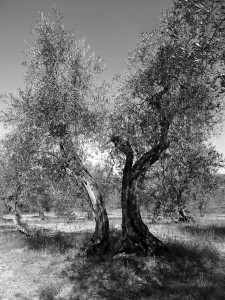
Cultivated for millennia in the Mediterranean region, the olive tree has become a constant presence in its landscape and an important element of the farming economy.
It grows well in sunny and dry terrain and gives an abundant harvest if pruned regularly. It grows very slowly and is extremely long-lived, ancient specimens still resist in Greece, in Palestine and in southern Italy.
The olive tree (Olea europea) is an evergreen that can grow up to 15 meters high. It has a twisted trunk, often hollow, with a greyish bark. The opposite leaves, leathery are lanceolate and have an entire margin; dark green on the upper side and silvery gray on the bottom, when they move with the wind they give the color variations that make the landscape of our countryside unique.
The small white flowers, called mignoli (pinkies), appear in late spring. The olive (the fruit), ripens in autumn, and is an oval drupe, with a red-purple or almost black skin, a wooden kernel containing the seed and a yellowish pulp rich in oil, which is obtained by crushing the olives.
In our area the most common variety, documented already in the seventeenth century, are those of the Leccino, Moraiolo and the Frantoiano.






